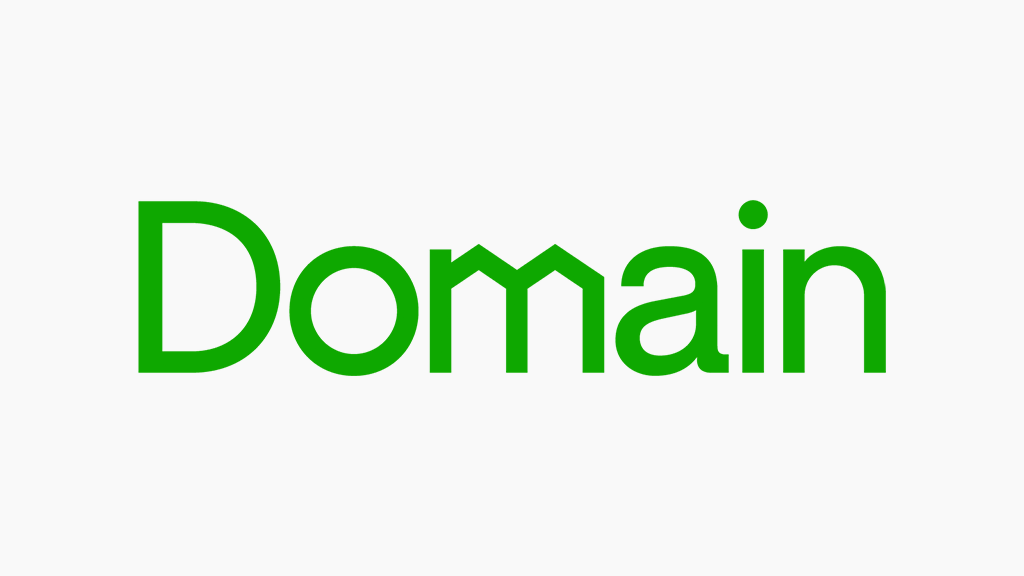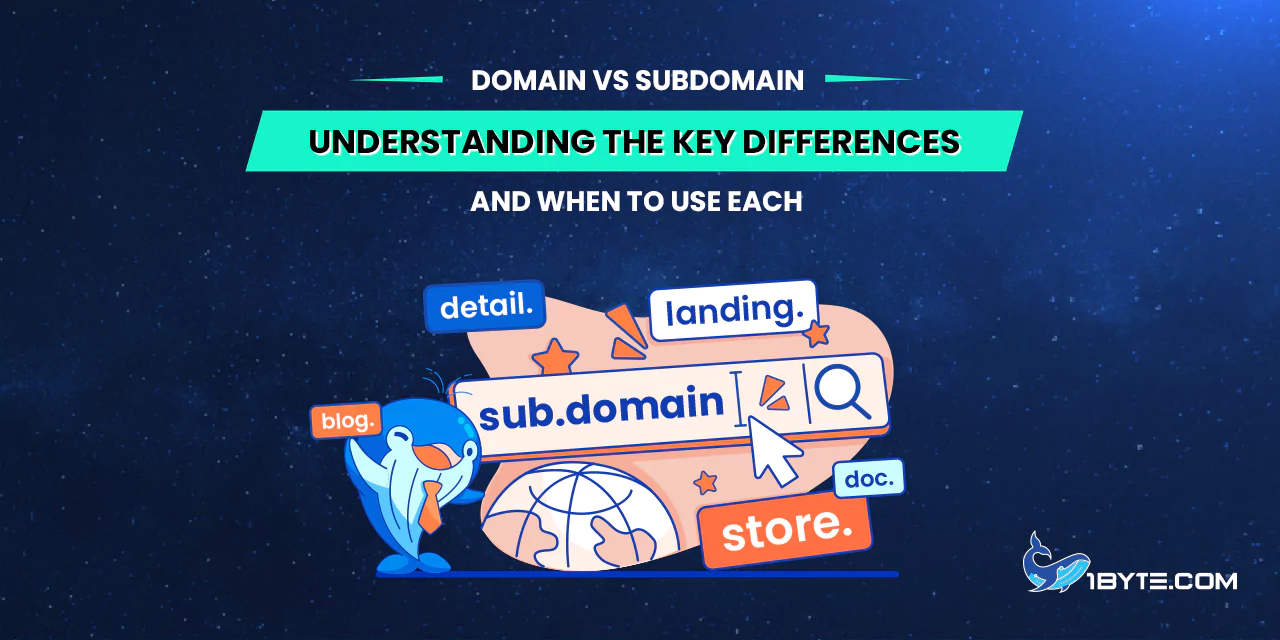Embarking on the journey of establishing an online presence requires crucial decisions, and at the forefront is the choice between a domain and a subdomain. Understanding the nuances in the discussion of “domain vs subdomain” is pivotal for anyone navigating the digital landscape. This article from 1Byte delves into the key differences between the two and guides you on when to opt for a domain or a subdomain, ensuring your online venture aligns seamlessly with your goals and objectives.
Domain Basics
Enter the realm of website management, where the choice between domain vs subdomain sets the stage for your online presence. Understanding the basics of a domain is the first step in navigating this digital landscape.
FURTHER READING: |
| 1. The .biz Domain Meaning: A Deep Dive |
| 2. What Is .mil Domain? Exploring Its History and Mission |
| 3. How to Get an .edu Domain for Your University |
Definition and purpose of a domain
A domain, also known as a domain name, stands as a distinctive label for a specific section of the internet, such as a website. This unique name plays a crucial role in the structure of Uniform Resource Locators (URLs), guiding users to a web resource within the hierarchical Domain Name System (DNS).
Its primary purpose is to offer a simple and recognizable name to a website, allowing both users and browsers to easily comprehend it. Without domains, websites would solely be identified by their numerical IP addresses, like 256.185.138.912, making navigation a complex task.

In the grand scheme of the Internet infrastructure, domains serve as human-readable addresses for web servers worldwide. This accessibility extends to any Internet-connected computer, reachable through a public IP address, be it IPv4 (e.g., 192.0.2.172) or IPv6 (e.g., 2001:db8:8b73:0000:0000:8a2e:0370:1337).
Registration and renewal of domains are facilitated by domain name registrars, likening the process to maintaining street names for effective navigation. Just as street names guide people, domains provide a user-friendly framework for locating and accessing web content.
Understanding the definition and purpose of a domain sets the groundwork for appreciating its role in the broader context of the online landscape. In the following sections, we’ll delve deeper into the intricacies of domains, examining how they differ from subdomains and when each is most effectively utilized.
Key considerations when choosing a domain
When choosing a domain, several key considerations can significantly impact the success and functionality of a website. The process involves more than just picking a name; it’s about aligning the domain with the goals and nature of the online presence.
Firstly, consider the relevance of the domain to the website’s content and purpose. A domain should clearly reflect what the website is about, making it easy for users to understand and remember. This relevance enhances the site’s visibility and resonates with the target audience.
Next, the length of the domain matters. Short, concise domains are generally more memorable and user-friendly. Avoid overly complex or lengthy names that might be challenging for users to recall accurately.
The inclusion of keywords in the domain can boost its search engine optimization (SEO). Choosing keywords related to the website’s content can positively impact how search engines index and rank the site. This strategic approach improves the website’s visibility in search results.
Another crucial consideration is the domain extension, such as .com, .org, or .net. While .com remains the most popular and widely recognized, different extensions can convey specific information about the website’s purpose or origin. Selecting the right extension contributes to the overall professionalism and credibility of the site.
Additionally, it’s essential to avoid using hyphens or numbers in the domain. Such elements can cause confusion, making it harder for users to type or remember the website address accurately. A clean and straightforward domain enhances user experience.
The registration of a unique and memorable domain is crucial to building a brand identity. A distinctive domain sets the website apart from competitors and fosters brand recognition among users.
Subdomain Basics
While the domain serves as the primary identifier for a website, subdomains add another layer of organization to the digital space.
Definition and purpose of a subdomain
A subdomain acts as a prefix, serving to segregate specific sections within a website. This separation is particularly useful for site owners managing extensive content hierarchies, such as online stores, blogs, job boards, or support platforms.
These subdomains essentially function as individual websites, distinct from the main domain. Picture them as dedicated districts within a city, each with its own unique identity and purpose while still belonging to the broader urban space.

The primary purpose of a subdomain is to enhance website organization and user navigation. By utilizing subdomains, site owners can provide users with clear pathways to different sections, facilitating a seamless and intuitive browsing experience.
Moreover, subdomains contribute to maintaining a clean and user-friendly link structure. Instead of appending a long page path to the end of a link, a concise one-word subdomain can be added to the beginning. This practice not only simplifies links but also aids in readability and memorability for users.
Advantages and limitations of using subdomains
Exploring the use of subdomains reveals both advantages and limitations, offering valuable insights for website owners seeking an optimal digital strategy.
Advantages
Firstly, subdomains provide an effective means to manage extensive sections within a website. This organizational structure allows site owners to create dedicated spaces for different purposes, enhancing clarity and functionality.
Furthermore, subdomains facilitate improved user navigation. Users can easily discern and access specific sections, fostering a seamless and user-friendly browsing experience. This targeted navigation contributes to higher user satisfaction and engagement.
Another notable advantage is the potential for customization. Each subdomain operates as a distinct entity, offering the flexibility to tailor the design, content, and functionality to the specific needs of its designated section.
Limitations
On the flip side, the use of subdomains may lead to a potential dilution of overall domain authority. While each subdomain operates independently, the collective impact on the main domain’s SEO can be affected. It’s essential to strike a balance and carefully consider the SEO implications.
Maintenance can pose a challenge, especially when managing multiple subdomains. Updates, security measures, and overall maintenance require dedicated attention for each subdomain, potentially increasing workload and complexity.
Additionally, users might find it confusing to navigate between the main domain and its subdomains. Striking the right balance between segmentation and cohesion is crucial to avoid user disorientation.
Domain vs Subdomain: Key Differences
Domains, the cornerstone of online presence, represent the main address of a website. In contrast, subdomains are extensions of the main domain, carving out specialized sections within the overarching website. The key differences between domain and subdomain lie in their functionality, purpose, and impact on user experience.

Definitions
Let’s sum up the previous sections with a final comparison of the definitions of a domain vs subdomain. We will make it short, so that the definitive outlines for both are clear.
Domain
- Think of a domain as the address of your house. It’s the main location where people can find you or your business on the internet.
- For example, in the URL “www.example.com”, “example.com” is the domain.
- It’s unique to your website and no two websites can have the same domain.
Subdomain
- A subdomain, on the other hand, is like a specific room within your house.
- It’s part of the larger domain, but it serves its own purpose and has its own content.
- For example, in the URL “blog.example.com”, “blog” is the subdomain of the larger “example.com” domain.
- You can have multiple subdomains for different purposes, such as a blog, a web store, or a support page.
SEO implications for domains and subdomains
Understanding the implications of domains and subdomains on Search Engine Optimization (SEO) is crucial for website owners aiming to enhance their online visibility.
Domains play a pivotal role in SEO, serving as the primary identifier for a website. The choice of a well-chosen domain name can positively impact user perception and make the website more accessible to search engines. It is essential to select a domain that is relevant, memorable, and incorporates keywords related to the content.
On the other hand, subdomains are treated as separate entities by search engines, leading to distinct SEO metrics for the main domain and its subdomains. While subdomains can be advantageous for organizing content, providing in-depth information, boosting SEO, and maximizing geo-targeted pages, it’s crucial to recognize that their metrics operate independently.
A high-traffic subdomain with numerous backlinks does not necessarily contribute to the SEO of the main domain. This separation of metrics can complicate the analysis of aggregated data, making it harder to assess the overall SEO performance.
Despite their potential benefits, subdomains should be utilized judiciously. Not every website requires subdomains, and their use should align with the website’s content and offerings. Website owners must weigh the advantages of content organization and targeted information against the potential fragmentation of SEO metrics.
Impact on user experience and brand identity of a domain vs subdomain
Exploring the impact of domains and subdomains on user experience and brand identity unveils significant considerations for website owners striving to create an engaging and recognizable online presence.
User Experience
In the realm of user experience, a well-chosen domain name plays a pivotal role in enhancing user perception and accessibility. Acting as the central entity, it serves as the primary address of the website, simplifying the navigation process for users.
On the other hand, subdomains offer a distinct approach by organizing website content, providing detailed information on specific topics, and improving user navigation. However, the potential downside lies in the fragmentation of SEO metrics, posing challenges for the analysis of aggregated data.
Brand Identity
For brand identity, the domain typically serves as the face of the brand, enabling users to easily recognize and remember it. This internet address embodies the brand or business name, contributing to a strong and memorable online identity.
In contrast, subdomains can be employed for niche targeting or for different sections of a website, such as a blog or a store. Despite their organizational benefits, subdomains may face challenges in brand memorability. Dependent on the parent company’s Top-Level Domain (TLD), subdomains risk being less memorable than companies with their own domain names, requiring users to recall both brands for immediate access.
Other technical distinctions between a domain vs subdomain
Dive into the technical distinctions between a domain vs subdomain to grasp their impact on website structure, security, and functionality.
Domains
A domain stands as the principal web address, representing the main entity users recognize when searching for a website. It serves as the central hub, typically used to create a brand and build domain authority through centralized backlinks.
For security measures, domains require an SSL certificate and other protections like domain privacy. Tracking domain traffic and performance can be accomplished by integrating the domain with tools such as Google Analytics.
Subdomains
In contrast, a subdomain is a subsection of a domain, offering a more specialized address within the website. Subdomains are commonly used for extending the website’s address, but it’s crucial to note that search engines treat subdomains as separate entities, not contributing to the SEO of the main domain.
Subdomains have their own set of security requirements, necessitating a dedicated SSL certificate with a potential risk of subdomain takeover. Effective tracking of user movement from the domain to the subdomain requires subdomain tracking.
Structural Appearance
Examining structural appearance, a root domain like “example.com” maintains a straightforward structure with the domain name followed by the top-level domain. In contrast, a subdomain, like “blog.example.com,” places the subdomain in front of the root domain.
Hierarchy & Relation
Considering hierarchy and relation, the root domain serves as the primary address and central entity, while the subdomain is a subset of the main domain. For the main website representing the core brand, a root domain is preferred, while subdomains are ideal for niche cases like blogs or customer support pages.
Branding & Recognition
From a branding perspective, the root domain typically represents the leading brand, making it easily recognizable. The domain acts as the face of the brand, while subdomains serve specific and distinct purposes.
These technical distinctions provide a comprehensive understanding of the roles, functionalities, and considerations when deciding between a domain and a subdomain. As website owners navigate the digital landscape, these insights become crucial for effective online presence and strategy.
Leverage 1Byte’s strong cloud computing expertise to boost your business in a big way
1Byte provides complete domain registration services that include dedicated support staff, educated customer care, reasonable costs, as well as a domain price search tool.
Elevate your online security with 1Byte's SSL Service. Unparalleled protection, seamless integration, and peace of mind for your digital journey.
No matter the cloud server package you pick, you can rely on 1Byte for dependability, privacy, security, and a stress-free experience that is essential for successful businesses.
Choosing us as your shared hosting provider allows you to get excellent value for your money while enjoying the same level of quality and functionality as more expensive options.
Through highly flexible programs, 1Byte's cutting-edge cloud hosting gives great solutions to small and medium-sized businesses faster, more securely, and at reduced costs.
Stay ahead of the competition with 1Byte's innovative WordPress hosting services. Our feature-rich plans and unmatched reliability ensure your website stands out and delivers an unforgettable user experience.
As an official AWS Partner, one of our primary responsibilities is to assist businesses in modernizing their operations and make the most of their journeys to the cloud with AWS.
Conclusion
Understanding the technical disparities between a domain vs subdomain, it becomes clear that a domain serves as the primary web address, creating a centralized entity for brand representation and building domain authority. On the other hand, subdomains, while beneficial for niche content and specialized sections, operate independently, requiring careful consideration of their impact on SEO metrics.
When deciding between a domain and a subdomain, website owners should align their choice with their goals and content structure. A root domain proves invaluable for the main website, reflecting the core brand and influencing overall domain authority. Subdomains, while providing organizational benefits, should be utilized judiciously, recognizing the potential challenges of separate SEO metrics.
In the dynamic landscape of website management, each choice contributes to user experience, brand identity, and SEO performance. By weighing the technical distinctions and understanding when to use each, website owners can navigate the digital realm with confidence, ensuring their online presence aligns seamlessly with their objectives and resonates effectively with their audience.

